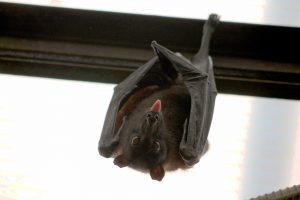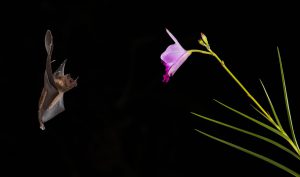Swooping through the night sky, many people are quick to decry bats as blood suckers, rabies vectors, and a general nuisance. However, these miraculous flying mammals pose little risk to humans and are actually essential in managing our ecosystems.
Home to 13 species of bats, it’s important that we Floridians know the facts. So read on to help in the effort to combat bat myths. You can also join one of our virtual or in-person classes on bats in the month of October. Register HERE
Alternately, watch our Wild Sarasota webinar: Florida’s Native Bats! for more on the bat species found in Florida, conservation efforts, and welcoming bats to your backyard.
Read all our Wild Sarasota blogs HERE
Myth #1: Bats are blood-sucking fiends

While there are some species who rely on blood as their food source, only 3 of the 1,300 species of bats consume blood. All three of these species, the Common Vampire Bat, the Hairy-Legged Vampire Bat, and the White-Winged Vampire Bat, reside in Central and South American and are not found in the United States. The species found here are largely insectivores (insect-eaters) and frugivores (fruit-eaters). But even if you are in an area with vampire bats, there’s very little need for concern. Vampire bats target livestock — who don’t even notice the bats’ presence — and rarely bother humans.
Myth #2: All bats carry rabies

Only half of 1% of bats in Florida carry rabies, so the chance of an encounter with a rabid bat is very slim. Moreover, unlike other animals, bats do not become aggressive when rabid so there’s an even lower chance of transmission.
That said, bats with rabies are often found on the ground so never pick a bat up. If you do see a sick or dead bat, report the incident to FWC.
Myth #3: Bats will nest in your hair

Bats roost, not nest. Instead of building a nest of their own, they roost (or hang) in caves, trees, or manmade structures.
So while a bat may fly close by in pursuit of an insect, they will not nest in your hair. Some even say this myth was popularized to keep young girls from going out at night.
The Truth About Bats: Bountiful Benefits
Free Pest Control
Bats are a phenomenal example of integrated pest management (IPM), or natural and economical ways of killing and deterring pests. All of Florida’s bats prey on insects and some are capable of eating upwards of 1,000 insects per night.
Economically, this free function of bats translates to billions of dollars of free pest management annually. So instead of paying to spray insecticides that often have unwanted consequences, bats are a logical and natural solution.
Pollination and Seed Dispersal

Fruit and nectar consuming bats act as pollinators and seed dispersers encouraging the reproduction of many key species. More than 20 genera of flora, including some in Florida, rely on bats as pollinators. Plants like wild bananas, guava, dragon fruit, some agaves, and others are pollinated by bats. This is especially true out west and in other countries where bats are especially adapted to eat and pollinate nocturnal and oddly shaped plants helping with cross fertilization and seed dispersal.
Fertilizer
Guano, or the excrements of bats, are particularly nutrient rich. With a 10-3-1 NPK ratio, the high nitrogen and phosphorous content of their droppings acts as a fertilizer bomb increasing soil quality wherever they defecate.
Science and Medicine

Studying bats has been instrumental in the advancement of different modern technologies. We can accredit the development of sonar and various aids for the visually impaired to research on bats. Additionally, bats’ consumption of mosquitos acts as vector control and minimizes the chance of transmission of mosquito-borne illnesses and their saliva contains an anticoagulant that helps with human blood clotting.
What else do you not know about bats? Continue your education and learn more about our 13 native bat species with our Wild Sarasota webinar: Florida’s Native Bats!
 0
0
